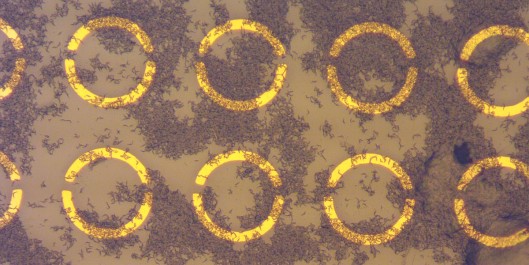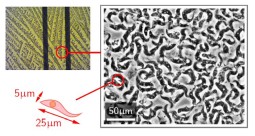Electromagnetic THz- and mm-wave Sensors for African Trypanosomes using RNA Aptamer-Derivatized Surface Layers
Phase 1 and 2
We propose the development of electromagnetic (EM) sensors for the detection of African trypanosomes, the parasitic organism that causes African sleeping sickness. If left untreated, sleeping sickness is fatal and thus, early detection of the parasite in blood samples of infected patients is of the essence.
Project Head:
Prof. Dr.-Ing. Christian Damm, Institut für Mikrowellentechnik, Universität Ulm
Prof. Dr. H. Ulrich Göringer, Molecular Genetics, Technische Universität Darmstadt
Dr. Daniel Neumaier, AMO GmbH Aachen
Research Team:
Dr. Robert Knieß, Molecular Genetics, TU Darmstadt
Dr. Ulrich Plachetka, AMO GmbH Aachen
Dr. Bartos Chmielak, Aachen
Simon Sawalich, Aachen
Mario Müh, Institut für Mikrowellentechnik und Photonik, TU Darmstadt
Objectives
Overall aim: The aim of this project is the development of sensor structures based on the combination of electromagnetic (EM) sensors and biological functional layers for the detection of pathogenic agents. For this purpose, different types of electromagnetic sensor structures in the range of mm- and THz-waves will be studied. Since the functional layers are very thin (monolayers in the nanometer range) compared to the electromagnetic wavelength (3mm – 100µm), structures with very high sensitivity are required. To enable sufficient interaction between EM-fields and biolayers, a strong subwavelength field confinement has to be applied.
The types include resonant as well as non-resonant structures with different waveguiding principles, mostly based on periodic structures and metamaterials. For the functionalization of these sensors, nucleic acid (NA)-aptamer layers will be studied. The goal of the project is to evaluate the sensitivity of different EM-sensor approaches and the detection limit of the pathogen. Different possibilities to increase the sensitivity by increased interaction between electromagnetic fields and functional layers and the exploitation of frequency-specific spectral features of the considered functional layers will be used to reach the lowest possible detection limit.
As a first step, a thorough electromagnetic characterization of possible functional layer types and possible substrates compatible with the EM-structure as well as the biological functionalization is necessary. With that knowledge, appropriate sensor structures can be designed. Passivation or seed layers for the immobilization of the aptamers on top of the structure have to be evaluated in terms of their electromagnetic, biochemical and technical processing properties to guarantee strong bonding of the functional layer and low influence on the electromagnetic readout at the same time.
The previous work on the THz-detection of surface-bound biomolecules has been mainly limited to DNA molecules. The planned project will extend the research to RNA-aptamers because of their high biomedical relevance and the expected presence of conformation-specific absorption bands in the low THz-range. This step is not trivial since RNA-molecules require surrounding water molecules for the stabilization of their molecular structure. Thick layers of water (>100µm) are however critical in terms of THz-absorption. The project will hence start with the investigation of molecules which can be measured in dried conditions and then proceed to biomolecular layers covered by a liquid layer.
Surface-bound NA-monolayers have the advantage of high molecular stability even in the case of a dried surface. This stability is very helpful for the fabrication and handling of biochips, which are based on an array of sensor spots with characteristic probe molecules (e.g. aptamers) bound to each of the sensor spot surfaces. Without loss of the bio-functionality of the surface-bound RNA-molecules it is possible to carry out measurements in dry conditions where measurements at THz-frequencies can be conducted without being hindered by the absorption of a fluid surrounding. However, one disadvantage of surface-bound NA-monolayers is that specific THz-absorption bands could not be measured on such layers so far. Reasons for this situation might be given by the extremely low thickness of the monolayer and the application of relatively small molecules such as oligonucleotides with a length of only 25 nucleotides (t < 10nm). The frequency of the lowest order collective vibrational modes might hence still be above the spectroscopical accessible range or the interaction length might be too short to generate a measurable contrast. Therefore, an important objective of this project will be to increase the interaction of the THz-excitation field with the aptamer films by using field concentrating nano-gap structures embedded in planar metallic THz-resonators. The THz-resonance is governed by the micron-scale dimensions of the resonator. Increased local field enhancement is achieved by the implementation of nano-scale gap structures into the planar resonators.
By localizing the aptamer probes at the positions of local field enhancement it is intended to amplify the sensitivity to the biomolecular collective vibrational modes to such a level, which allows the selective sampling of specific absorption bands. This approach shall not only allow the increase of the sensitivity but also the selectivity of the THz-based detection of biomolecules due to the narrow-band frequency selective sampling of aptamer-specific resonances on the biochip. In order to explore the physical and technical limits of the sensitivity of the THz biochip approach a further objective of this project is to implement a near-field read-out head for the direct sampling of singular resonators of an array in contrast to the conventional collective read-out of multiple coupled resonators by a diffraction limited THz-beam. The new approach should enable a sensitivity increase by approx. more than a factor of 25 due to the reduction of required sample material and the direct sampling of enhanced field amplitudes in the near-field of each resonator in contrast to scattered far-field amplitudes which are expected to be more than two orders of magnitude lower.
The lack of suitable diagnostic tools in developing countries is a major stumbling block for disease control. This holds especially true for African trypanosomiasis. Simple, accurate and reliable diagnostic tests are essentially missing for both forms (chronic/acute) of the disease. As a consequence, the scientific and technological objective of the proposal is the design of an EM-based detection device for the diagnosis of African trypanosomiasis in livestock and human blood samples. For that we will make use of a panel of chemically modified RNA-aptamers specific for different surface proteins of the parasite, which can capture the pathogen with high specificity and high affinity. The proposal includes all necessary steps to demonstrate “proof-of-principle” of the EM-aptasensor approach and is intended to provide the groundwork for the design of a prototype-device for a fast, robust and low cost detection of African sleeping sickness.
Abstract
We propose the development of electromagnetic (EM) sensors for the detection of African trypanosomes, the parasitic organism that causes African sleeping sickness. If left untreated, sleeping sickness is fatal and thus, early detection of the parasite in blood samples of infected patients is of the essence. The EM-sensors will operate in the mm- and THz-frequency region. They will by functionalized with a layer of chemically resistant, trypanosome-specific RNA-aptamers. Aptamers represent synthetic, biomolecular affinity reagents that are capable of binding to the surface of parasite cells with high specificity and high affinity. The minute dielectric change as a result of the aptamer/trypanosome binding reaction will be detected. In addition, we will exploit the spectral absorbance characteristics of aptamers due to inherent molecular resonances and their change after the parasite-binding event to increase the sensitivity of the detection.
Two different sensor structures, one on the micro- and one on the nanoscale, will be developed and analyzed. They are based on subwavelength resonators and metamaterials. Both rely on strongly confined EM-fields for the interaction with the aptamer monolayer with high quality factor resonances. The nanoscale structures will be read out using nearfield probes, which specifically will be developed for that purpose. The microscale resonators will be measured using standard mm-wave and THz-instrumentation. The aptamers will be synthesized enzymatically and chemically. Different coupling chemistries to support materials for the immobilization will be scrutinized. Factors such as the aptamer surface density will be studied with respect to its influence on the EM-readout. Porous three-dimensional glass and polystyrene spheres will be evaluated as aptamer support substrates, allowing larger EM-signals due to larger aptamer volume fractions. The aptamer layer itself will also be optimized for higher EM-signals. This will be done by synthesizing dimeric and trimeric aptamer arrangements. Due to their larger size, EM-sensor readouts should be increased.
The motivation for the proposed project is manifold. The lack of suitable diagnostic tools in developing countries is a major stumbling block for disease control. This holds especially true for African trypanosomiasis. Simple, accurate and reliable diagnostic tests are essentially missing for both, the acute and chronic form of the disease. We anticipate that biofunctionalized EM-sensors can contribute to alleviate the situation by providing cheap, flexible and robust on-site diagnostic devices. Recent advances in mm- and especially THz-instrumentation pave the way for sensor applications in this field.
The range of frequencies is especially attractive, because the penetration depth is higher than in the optical region and optically opaque materials are no hindrance. Furthermore, many biological molecules show unique spectral features in this range, which can be exploited. The miniaturization, spatial resolution and sensitivity are inherently larger than for lower frequencies. We chose aptamers as functional layers because of their flexibility to adapt to numerous ligands emphasizing the universal applicability of our approach.
Publications
Maasch, M.; Mueh, M. & Damm, C. Sensor Array on Structured PET Substrates for Detection of Thin Dielectric Layers at Terahertz Frequencies 2017 IEEE MTT-S International Microwave Symposium (IMS), 2017
BestStudentPaper Award: Mueh, M.; Maasch, M.; Brecht, M.; Göringer, H. U. & Damm, C. Complex Dielectric Characterization of African Trypanosomes for Aptamer-based Terahertz Sensing Applications Proceedings of IMBIOC 2017, 2017




